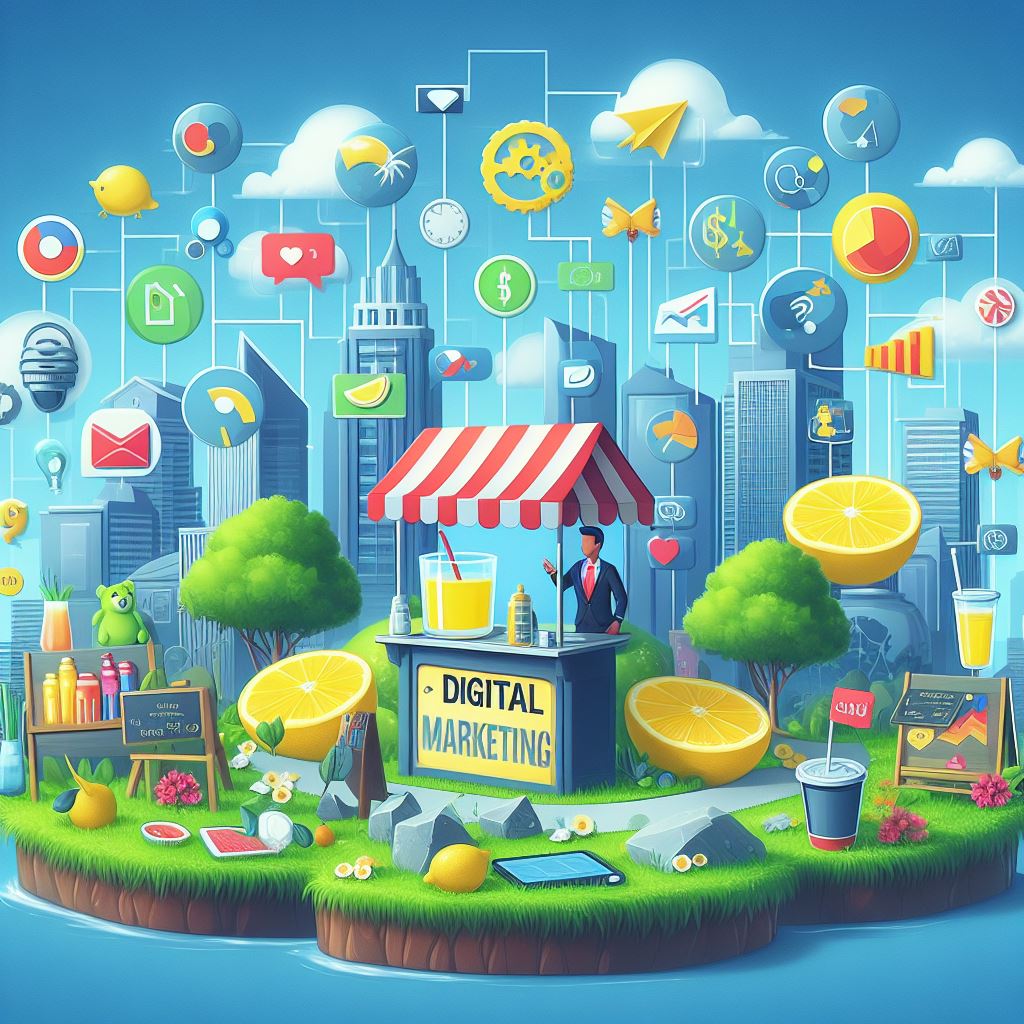
Digital Marketing : Trends, Strategies and Tools for Success

Digital marketing is like a super tool for businesses today. It’s not just about putting ads online anymore. Now, it’s about using different ways on the internet to talk to people and make them interested in what you’re selling. Imagine you have a lemonade stand, and you want to tell everyone in your neighborhood and even in the whole town about it. Digital marketing helps you do that but on the internet. It’s cool because now even small businesses, like your lemonade stand. It can reach out to lots of people all over the world. This blog is like a treasure map that shows you the latest tricks. It’s smart ways to make people love your stuff and the best tools to help you along the way. So, if you want to be a hero in the online world, this guide is for you!
Understanding Digital Marketing
Digital marketing is like using your computer or phone to tell people about cool stuff you’re selling. Imagine you’re playing a game online, and you see an ad for a toy you really want—that’s digital marketing! Companies use places like Google, Instagram, Facebook, and email to talk to people. Who might want to buy what they have. It’s different from old-school ads you see on TV or in the newspaper because companies can chat with you directly on the internet, see what you like, and change their ads to match what you’re interested in. It’s like if you told your friend you love skateboards. Then they showed you all the coolest skateboards they know about. That’s how digital marketing works; it’s all about finding what you like and showing you more of it online.
The Components of Digital Marketing

At its core, digital marketing revolves around the following components:
Search Engine Optimization (SEO):
SEO involves strategically optimizing your digital presence to enhance visibility and ranking on search engine results pages (SERPs). It entails meticulous keyword research and incorporation. Aligning with user intent and enhancing website structure and content to resonate with search algorithms. By leveraging SEO effectively, you ensure that your website attains a prominent positioning akin to prime real estate, maximizing exposure and attracting organic traffic.
Content Marketing:
Content marketing revolves around crafting compelling narratives and engaging visuals to captivate and resonate with your target audience. It transcends conventional advertising by delivering value through informative articles, captivating videos, and visually appealing graphics across various digital platforms. By consistently providing relevant and valuable content, you establish credibility, foster audience engagement, and nurture lasting relationships. Its builds your clientele, ultimately driving brand affinity and conversion.
Social Media Marketing:
Social media marketing harnesses the power of social networking platforms to cultivate brand awareness, engagement, and loyalty. It entails crafting tailored content strategies that resonate with your audience demographics and align with platform dynamics. By fostering authentic conversations, sharing captivating visuals, and leveraging targeted advertising, you amplify your brand’s reach, cultivate community engagement, and foster brand advocacy, thereby driving measurable business outcomes.
Email Marketing:
Email marketing entails strategically leveraging personalized messaging to nurture leads, cultivate customer relationships, and drive conversions. It encompasses crafting compelling email campaigns that deliver relevant content, exclusive offers, and personalized recommendations tailored to individual preferences and behaviors. By nurturing leads through targeted email sequences and automation, you maximize customer lifetime value, foster brand loyalty, and drive sustainable business growth.
Pay-Per-Click (PPC):
PPC advertising empowers brands to strategically target and attract qualified leads through paid digital advertising channels. It involves bidding on relevant keywords and placing targeted ads on search engine results pages (SERPs) or other digital platforms. By paying only for actual clicks, PPC campaigns ensure cost-effective lead generation and measurable ROI. Through continuous optimization and data-driven insights, you maximize ad performance, drive website traffic, and achieve your marketing objectives efficiently and effectively.
Digital Marketing Trends in 2024

The digital marketing landscape is constantly evolving, with new trends emerging each year that can significantly impact the way businesses reach and engage their target audiences. Some of the key trends for 2024 include:
Personalized Marketing
Imagine you’re scrolling through your favorite app. You see an ad for the exact skateboard you were talking about with your friends. That’s personalized marketing in action. It’s all about companies making their ads feel like they were made just for you. They use what they know about you – like your likes, dislikes, and past shopping habits. By showing you products or services that you’re likely to be interested in. It’s like having a personal shopper who knows you so well, they always find the perfect thing for you. This approach makes ads less annoying and more useful because you’re seeing stuff that matters to you. Brands are getting smarter about this, using technology to make sure their messages hit the mark, making shopping feel more like a personal recommendation from a friend than a billboard shout-out.
AI and Automation
AI and automation are like the superpowers of digital marketing. Imagine having a robot assistant that knows exactly when to send an email to your customers, what to say to them, and how to speak to them to get them excited about buying something. That’s what AI and automation do for businesses. They can analyze tons of data about how people shop, what they like on social media, and when they’re most likely to make a purchase, then use that info to make marketing super efficient. It’s like having a marketing team that never sleeps, constantly figuring out the best way to connect with customers. This tech helps businesses create a shopping experience that’s smooth, personalized, and feels really natural, as if the brand really gets you.
Video Marketing
Video marketing is all about using videos to grab your attention and tell you a story that makes you want to buy something or learn more about it. With everyone glued to their screens, videos are the way to go. They can be anything from a quick TikTok showing someone using a new gadget to a YouTube tutorial about how to style your hair with a new product. Videos are so effective because they’re easy to watch and share, making them a powerful tool for brands to spread their message. Plus, they’re just more fun to consume than reading a long article. Whether it’s showing off a product in action or taking you behind the scenes of how something is made, video marketing makes everything more interesting and relatable.
Influencer Marketing
Influencer marketing is like when the popular kid in school shows up wearing a new brand of sneakers, and suddenly everyone wants a pair. Influencers are people who have a lot of followers on social media and can, well, influence their choices and opinions. Brands collaborate with these influencers to promote their products because when an influencer you like and trust talks about how great a product is, you’re more likely to be interested in it. It’s not just celebrities; there are influencers in all kinds of niches, from gaming and fashion to fitness and cooking. This type of marketing feels more genuine because it’s not the brand talking about how awesome they are; it’s someone you look up to and enjoy following. It’s a way for brands to connect with you through someone you already listen to and trust.
Effective Digital Marketing StrategiesÂ

To effectively navigate the digital marketing landscape, businesses must employ a combination of strategies that engage and expand their audience. Some of the most effective strategies include:
Content Marketing
Content marketing is all about giving your audience something valuable without asking for anything in return, at least not right away. It’s creating stuff like blogs, videos, podcasts, or infographics that people actually want to consume because it’s interesting, helpful, or entertaining. The goal is to address what your audience cares about, answering their questions, or solving their problems with your content. This way, you build a relationship with them. They come to see you as a trusted source, which is gold in the digital world. Over time, this trust turns into loyalty, and when they’re ready to buy something you offer, you’re the first place they’ll think of. It’s a long game, focusing on providing value upfront, which ultimately leads to conversions and sales.
SEO
SEO is the backbone of making your digital presence known. It’s all about tweaking your website and its content so search engines like Google show it as a top result when someone searches for something related to what you offer. This involves using the right keywords, making your site mobile-friendly, speeding up loading times, and ensuring your content rocks. It’s crucial because ranking higher in search results means more people find you without you having to pay for ads. The better your SEO game, the more organic traffic you get. This isn’t about tricking search engines but making your content genuinely the best answer to what people are searching for, which in turn drives more potential customers to your site.
Social Media Engagement
Social media engagement isn’t just about posting your stuff and calling it a day. It’s about starting conversations, joining in on others, and really connecting with your audience. You’ve got to be active, responding to comments, messages, and mentions, making your followers feel heard and valued. It’s also about sharing content that resonates with them, encourages interaction, and builds a community around your brand. This kind of engagement boosts your brand’s visibility and helps foster loyalty, as followers see your brand as more relatable and responsive. It’s a powerful way to turn your audience into advocates for your brand, extending your reach and influence on social media platforms.
Data-Driven Decision Making
Using data to guide your marketing decisions is like navigating with a map instead of just wandering around hoping to stumble upon treasure. By analyzing data from your website, social media, and other digital campaigns, you can see what’s working and what’s not. This means looking at metrics like traffic sources, engagement rates, conversion rates, and more to understand your audience’s behavior and preferences. With this insight, you can tweak your strategies for better performance, invest more in what’s working, and cut losses on what’s not. It’s about making informed decisions that improve your return on investment (ROI) and ensuring that every marketing dollar you spend is working hard for your business.
Must-Have Digital Marketing Tools
To implement effective digital marketing strategies, businesses need access to the right tools. Some essential digital marketing tools include:
SEO Tools
SEO tools, such as Google Analytics and SEMrush, are like your digital marketing compasses. They guide you through the vast online landscape by providing insights into how your website is performing. What people are searching for, and how you stack up against your competition. With Google Analytics, you can see how many people visit your site, how they found you and what they do once they’re there. It’s like having a spyglass that shows you the paths people take through your website and what catches their interest. SEMrush, on the other hand, is like having a map that reveals the terrain of the internet. It helps you find the best keywords to use, understand what your competitors are doing, and even spot opportunities for getting your website mentioned on other sites. These tools are essential for navigating the online world, helping you make informed decisions to attract more visitors and climb higher in search results.
Social Media Management Tools
Social media management tools, like Hootsuite and Buffer, act as your digital command centers. They let you oversee all your social media accounts from one dashboard, saving you the hassle of logging into multiple platforms multiple times a day. Imagine planning a week’s worth of posts for Instagram, Twitter, Facebook, and LinkedIn in one sitting. And then scheduling them to go live at the best times for engagement. These tools also provide analytics, which means you can see which posts your audience loves most and adjust your strategy accordingly. Plus, they allow for team collaboration, so if you’re working with others, everyone can contribute to and monitor your social media efforts. It’s like being the conductor of an orchestra, ensuring every section comes in at the right time to create a harmonious performance that captivates your audience.
Email Marketing Platforms
Email marketing platforms like Mailchimp and Constant Contact are your digital postmen, delivering your messages directly into the inboxes of your audience. These platforms offer much more than just a way to send emails; they allow you to design eye-catching email templates, segment your audience for personalized messaging, and analyze the success of your campaigns. Imagine sending out a newsletter that looks great on any device, knowing exactly who opens it, who clicks through, and what they’re interested in. This information is gold for refining your approach and making your emails more compelling. With features like automated campaigns, you can set up a series of emails to welcome new subscribers, follow up on purchases, or re-engage those who haven’t interacted with your brand in a while. It’s about making each email feel like a personal note, tailored to the interests and needs of its recipient.
Building a Digital Marketing Plan
Choosing the right tools depends on your business size, goals, and the specific strategies you plan to implement.
Set Clear Objectives
Before diving into the digital world, you need to know what you’re aiming for—like setting a destination before starting a road trip. Want to get more people to know your brand? Increase how many things you sell? Or maybe get more people to talk about your product online? Setting clear goals is like drawing a map for your journey. It helps you decide which roads to take and what supplies you need. Without a destination, you could end up driving in circles. So, think about what success looks like for you. Is it 1,000 new followers on Instagram? Doubling your website sales? More people signing up for your newsletter? Nail down your objectives first, and you’ll have a much clearer path to follow.
Understand Your Audience
Knowing who you’re talking to is crucial. Imagine trying to sell the latest gaming console to someone who only plays board games—it just wouldn’t work. You need to dig deep and understand the people you want to reach. What do they like? What problems do they have that you can solve? Where do they hang out online? It’s like being a detective, gathering clues to build a profile of your ideal customer. This isn’t just about their age or where they live but getting into their heads to understand their lifestyle, values, and habits. The better you know your audience, the easier it is to talk to them in a way that resonates and convinces them to stick around, engage, and eventually buy from you.
Choose Your Strategies and Tools
Once you know where you’re heading and who you’re talking to, you need to pick your tools and strategies. It’s like choosing the right gear for a hiking trip. Will you need climbing equipment or just a good pair of boots? In digital marketing terms, this could mean deciding between focusing on Instagram stories or writing in-depth blog posts, using email marketing or pay-per-click ads. Your goals and audience knowledge will guide this choice. Then, select the tools that fit your strategy—whether that’s software for scheduling social media posts, SEO analysis tools, or email campaign managers. It’s all about matching your tactics and tools to the journey ahead, ensuring you have everything you need to reach your destination effectively.
Implement, Measure, and Adjust
This is where you hit the road. Start rolling out your campaigns based on the strategies you’ve chosen. But the journey doesn’t end with implementation. You need to keep an eye on the map and the road signs—this means continuously tracking how well your efforts are doing against the goals you set. Are you gaining more followers, increasing sales, getting more website visits? Use tools to monitor these metrics, and be ready to tweak your strategy if things aren’t going as planned. Maybe you’ll find that Instagram works better for your brand than Twitter, or that your audience loves videos more than blog posts. It’s all about testing, learning, and adjusting your course as needed to keep moving towards your goals.
Conclusion
The digital marketing landscape is vast and complex, but by understanding the latest trends, employing effective strategies, and leveraging the right tools, businesses can achieve remarkable success. As the digital world continues to evolve, staying informed and adaptable is key to navigating this dynamic environment successfully.
We’d love to hear your thoughts and experiences with digital marketing. Share your stories in the comments below, and if you’re looking for more resources or assistance with your digital marketing efforts, check out my digital marketing services. Let’s navigate the digital marketing landscape together!

Nurnobi Islam
Digital Marketers & Content Creator


Maximizing ROI with Strategic Guide by Social Media Marketing Managers


